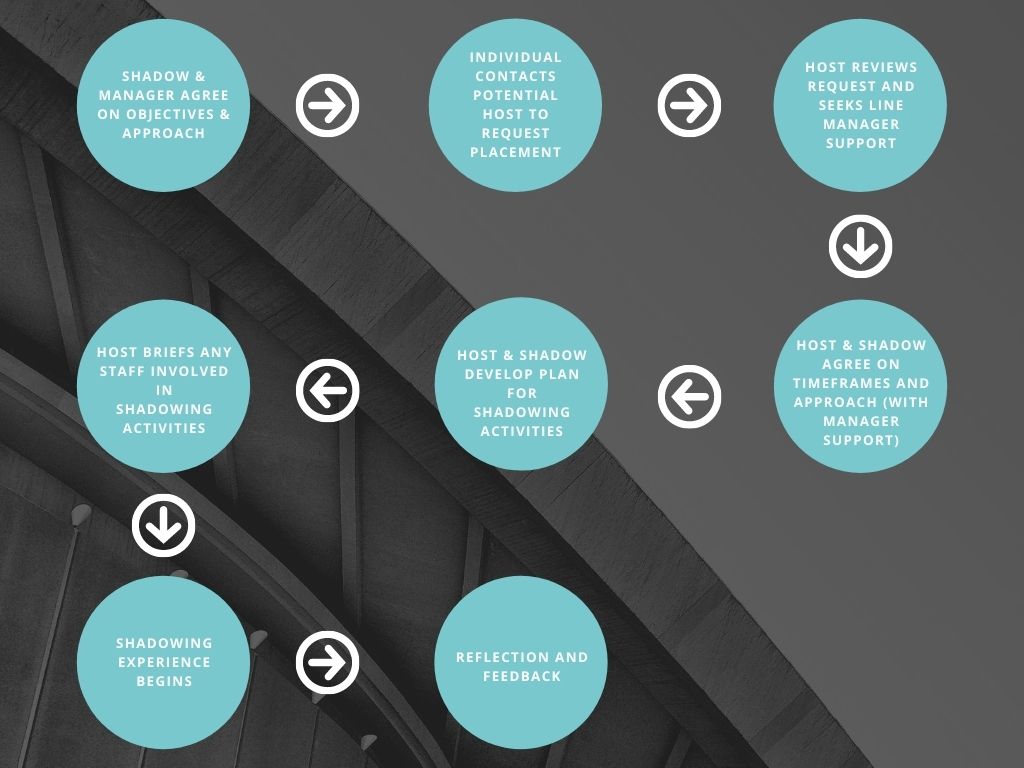
HR Guide: How Job Shadowing is Great for On-the-job Training
Create Job Description Using AI
Write appealing job descriptions for any job opening to attract the most qualifield and suitable candidates. FOR FREE.
try now
What is Job Shadowing?
Job shadowing is where an employee from an area of the organisation gets the chance to work alongside and learn about the role of another employee and gain experience in that particular work area.
Job shadowing can also be used to provide an employee within a department the chance to work alongside more experienced coworkers so they can learn and develop within their current position.
This type of on-the-job training is perfect for onboarding new employees and when longer-term employees wish to learn about different roles in the organisation. Job shadowing can provide enough knowledge about the new and different job to allay the employee's fear of the unknown.
It is also a useful tool when you want employees to have career opportunities through job transfers or lateral moves. It's also an essential component of the internship experience.
What is the big deal about job shadowing?
Job shadowing gives an employee a unique opportunity to learn about how other employees work and what their roles involve. It developed a deeper knowledge and understanding of other jobs and functions within the organisation.
Job shadowing can teach individuals to:
- See how other staff and teams work together
- Learn more about the roles and responsibilities of other members of staff and departments
- Can be used as a way to test one's possible career options
- Reflect and learn from colleagues
- See the bigger picture and understand more about how the organisation functions
But what can job shadowing offer for the individual being shadowed? Job shadowing provides these people with a chance to:
- Share their experiences with colleagues from a different department.
- Review and reflect on their work through discussions with the person shadowing them which allows them the chance to see their role through the new employees.
The 3 Roles of Job Shadowing
The Host
The Host is the one who agrees to be shadowed. They are responsible for planning for and carrying out the key shadowing activities which provide the Shadow with learning opportunities.
The Shadow
The shadow is the one visiting another team/department and/or observing a coworker, with the goal of learning more about the Host's role and work practices.
Line managers
The Shadow's current line manager plays a crucial support role in the job shadowing experience. The Shadow's manager should engage in discussions to make sure the activity is aligned with the individual's work or development goals, and to provide guidance and support when setting up the shadowing arrangement.
The Line Manager should also use the time to debrief with the employee after the shadowing assignment, helping them to:
- Reflect on their experience,
- Identify opportunities to transfer learnings to the workplace, and
- Determine future development goals.
The Line Manager of the hosting department should also agree to their team members' participation in any shadowing arrangements.
How it works

The recommended process for organising and completing a job shadowing placement.
-
Job shadowing can be requested for consideration by any employee seeking an informal development opportunity.
-
Staff should meet with the line manager to outline their interest, formulate the goals and objectives for the shadowing experience, and consider how the practicalities can be met
-
The Shadow identifies a suitable Host for the shadowing assignment, but a Manager can offer guidance and suggestions on possible candidates.
-
Each shadowing request depends on individual circumstances and must be considered on its own merits before any agreement is made. It may not be possible for all requests to be fulfilled.
-
Once an individual and their Line Manager have reached agreement on the shadowing goals, it's the Shadow's duty to begin the shadowing relationship. It is then the discretion of the person receiving the request to determine whether they can agree to the placement.
-
The Line Managers of both the Shadow and the Host should support the shadowing arrangement. Everyone involved in job shadowing should know what is expected of them and everyone is clear what actions they will take during the entire length of the job shadowing.
3 Types of job shadowing
Observation
The Shadow will spend the agreed period of time observing the day to day work of the Host. This involves a range of activities such as attending meetings, watching interactions with customers and so on.
It should be a regular representation of what the Host does on a daily basis. This type of shadowing is best for Shadows who look to gain a greater understanding of what the Host's job role actually consists of.
For example, if someone is considering a career change but isn't quite sure if they fully understand what is involved in that role, a job shadowing can give them the chance to explore this further.
Regular briefings
The Shadow will follow the Host for specific activities over a period of time which are all preceded by a mini brief and follow up debrief. This works best when the Shadow works near to the Host and the Host can then advise them of dates and times of specific activities which are of value in understanding the role of the Host.
This type of shadowing provides short periods of focused activity, rather than passive ongoing observation. But, it needs careful timing and planning if it is not to become disruptive.
Hands-on
This is an extension of the observation type, where the Shadow starts to undertake some of the duties they have observed. This provides the Shadow with hands-on experience of the job while having the safety net of being closely supervised by the Host.
This is not always possible and would need further discussion on a case by case basis between the Host and the Shadow.
A job shadowing program for employees can be a great way for qualified employees to grow within an organisation.
Are You Short on Staff? Reach four millions of job seekers on Maukerja, Ricebowl, LinkedIn, Jora, Trovit, and more when you post a job on AJobThing.com
Post a job today!
Sources: MMU, the balance careers & Macquarie University
Articles you may be interested in
HR Guide: The Process of Employee Promotion
HR Guide: Conflict Management Between Bosses and Employees
HR Guide: How to Manage Confidentiality in the Workplace





